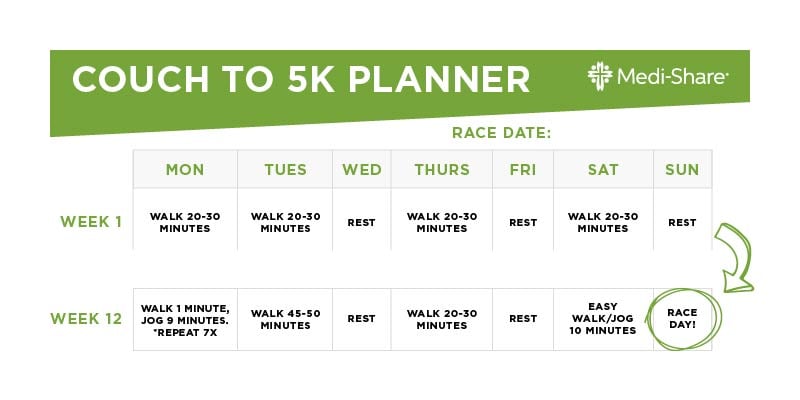We’re just over a month into a new year and motivation is high! It is exciting to look ahead at your health goals and eagerly begin working to achieve them as quickly as possible. Increasing energy, aerobic endurance, and overall physical fitness can happen this year, whether it’s a distance race or a fun run.
However, with all of the various options, programs, and resources out there, there may be a bit of uncertainty as to where to start.
How do you know what to do first? How much do you push yourself at the very beginning? How do you prevent injury while still challenging your body to adapt and get stronger?
Although these questions can be an initial challenge, there is no need to worry! It’s common to be a bit unsure as to where to start when embarking on a new health adventure or fitness endeavor. With a few simple steps, you can be well on your way to achieving your cardio goals this year.
1. Establish your end goal
Before you can start out on a new workout plan, establish exactly what you are pursuing and the desired outcome. With a destination in mind, map out how to get there in the most efficient and safest way possible rather than aimlessly striving toward an unknown end. Ensure the end goal is specific enough that progress is able to be measured along the way (i.e.: I will run a fun 5k event in 6 months.)

2. Determine your starting point
Now that you’ve determined an end goal, assess where you are starting. Take the goal of running a 5k in 6 months for example. If you have not previously been doing any cardiovascular activity, it would not be very beneficial or safe for your body to attempt to run a 5k right off the bat.
After getting clearance from your doctor to start exercising, first work up to that desired distance by starting off with some daily walking or very slow, easy jogs to determine a baseline for your endurance because going too hard too fast could put you at risk for injury. An initial workout could even include a combination of walking and jogging to reach a desired amount of time (such as jogging for 1 minute followed by walking for 1 minute and repeating that combination 10 times, equaling a total of a 22-minute cardio workout).
However, if you have been performing some cardiovascular exercise a few days per week, you may be able to start a program that jumps right into running longer distances because your body is already somewhat conditioned to handle the physical challenge or load. Take what you have already been doing for some time and add time and/or distance to challenge yourself as you push toward the distance of a 5k.
You could even do the same jog and walk combination, but at a higher intensity level (such as jogging for 3 minutes followed by walking for 1 minute and repeating that combination 10 times, equaling a total of a 40-minute cardio workout).
3. Follow a workout plan
Now that a starting point has been determined, finding a workout that will support you in that example goal to run that 5k is much easier. As previously stated, the correct cardio workout plan should be a challenge, but not be impossible to achieve. You should end your workout slightly out of breath, but not gasping for air and unable to speak.
If you are just starting out, a “couch to 5k program” may be a great workout program to follow. However, if you are already fairly conditioned, a program that starts at a higher intensity level may be a better fit.

*If you are a Medi-Share Health Partner, you have exclusive access to the full “Couch to 5K Planner” as well as personal health coaches through your Member Center. Schedule today!
4. Understand progression
No matter your experience level or age, approaching a new exercise while erring on the side of caution is key to determining what your body is capable of performing safely. Experiment with different distances, speeds, modalities (i.e.: jogging vs biking), and weekly volume to ensure each workout is difficult, but still achievable without injury.
If a workout feels too easy, that’s a great sign that it is time to up the overall intensity because your body is building in strength and endurance! Monitor your soreness levels as well to ensure you are pushing your body to get stronger, but not so much so that you are sore for several days after a workout is completed. Give your body time to progress, but not so much time that progress stalls out. The body needs to be consistently challenged in order to stimulate the adaptation needed to increase overall endurance and physical ability.
Be mindful of injury prevention as you progress by incorporating a proper warm-up and cool-down to each workout session, fueling your body with the proper nutrition, and adequate recovery in between each bout of exercise. Proper footwear is also needed to ensure your joints have the support needed to stay healthy and strong.
To prevent overuse injuries, cross-training (with various cardio modalities and strength training) can even be explored to ensure workouts are varied and different sets of muscles are routinely challenged.
5. Give yourself grace
Pursuing a new aerobic goal (like running a fun 5k event) does not have to be or look perfect, but by following these simple steps you can have the confidence and the knowledge of how to work toward your goal starting with the very first workout. Anything that is new is most likely to be accompanied by some trial and error, so be patient and enjoy the process in working toward increased endurance and overall better health.
Now you know how to incorporate a new cardio workout into your regular routine that will get you one more step (pun intended) toward your goals! You know how to establish a goal, determine your starting point, follow a workout plan, and understand progression all the while giving yourself grace in the process.
Don’t let unanswered questions prevent you from achieving your goals. If you still aren’t fully confident, seek out support and expertise from a fitness professional for a tailored program that is designed specifically for you and your needs.
*Please consult with your doctor before starting an exercise regimen. The steps listed in this article do not take into account individual physical abilities and merely depict a general process to incorporating exercise into daily routine.






